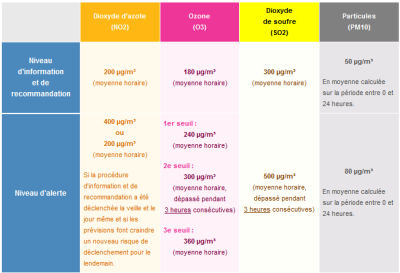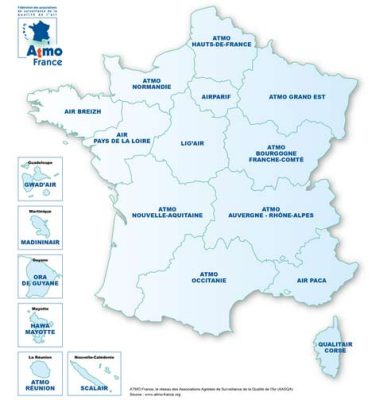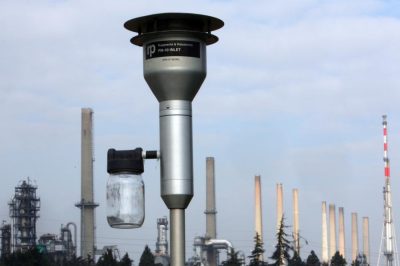法律如何保护空气质量?

空气污染问题由来已久(焦点#1),然而它依然是当代热点话题,因为人类愈加意识到空气污染对环境和健康的影响。在法国,环境空气质量管理是基于由近650个测量站组成的网络所监测的空气质量标准。空气质量能否达标与所采取的措施相关。这些措施包括应急措施,旨在快速恢复符合公共健康的污染物浓度;以及管制措施,旨在减少慢性污染。
1. 为什么要保护空气质量?
“空气污染是指人类直接或间接地引入,或存在于大气和密闭空间中的化学、生物或物理制剂,其后果可能危及人类健康,损害生物资源和生态系统,影响气候变化,损害物质财产,造成过度的气味滋扰”[1]。

受管制的污染物种类繁多:二氧化硫(SO2)、氮氧化物(NOx)、地面臭氧(O3)、一氧化碳(CO)、挥发性有机化合物和碳氢化合物(苯和苯并(a)芘)、重金属(铅、砷、镉、镍)和细颗粒物(颗粒尺寸小于10微米的悬浮颗粒:PM10和2.5微米。PM2.5)(图1)[2]。
欧盟的相关法律要求对这些污染物进行监测和监管(焦点2)。
1.1. 空气污染破坏环境

硫和氮的氧化物在水分的作用下会转化为硫酸(H2SO4)和硝酸(HNO2),造成大量湖泊的酸化。许多空气污染物(SO2、NOx、O3、氟……)具有植物毒性,即使浓度很低,也会造成叶片坏死,扰乱光合作用。长期接触会抑制植物生长。酸性物质还通过土壤发挥作用。它们会冲走土壤中的营养物质,导致植物缺钙、缺镁,并释放有毒化合物(铝和锰)。
氮化合物也会造成土壤富营养化。大气沉积过量吸收了植物的主要营养元素氮,造成营养失衡,严重破坏森林、沼泽和草原等敏感的生态系统(图2)。

氮氧化物还会与挥发性有机化合物(VOCs)一起导致臭氧(O3)的形成。然而,这种在平流层中保护地球免受太阳紫外线照射的气体,在对流层中也是一种强大的光化学氧化剂,有助于增强温室效应。臭氧还有很强的植物毒性,破坏光合作用,长期暴露于臭氧会抑制植物生长(图3)。
空气污染造成的这些不同影响不仅在局地很敏感,在国家、大陆甚至全球范围也同样敏感(焦点#3)。污染物跨越国界,随风飘移数百甚至数千公里。大气层的特殊性在这里得到了充分体现。大气是地球上流动性最强的元素,就其本质而言,它是排放到空气中物质的中转介质。如果这些物质落回地面,最终会污染水和土壤,进而污染生物圈。因此,大气具有自我净化的能力,许多物质通过沥滤(降水)或干沉降从大气中消失,或通过各种过程或反应(光解离、失活、化学消除)被迅速消除。
1.2. 空气污染严重影响健康
虽然仅从健康维度肯定不能概括控制空气污染所面临的挑战,但健康具有明确的优先地位。承认每个人都有权呼吸不损害健康的空气,就证明了这一点[3]。同样,空气污染的定义也包括花粉等生物制剂,它们是完全自然的元素,只是因为对人类有过敏作用才被视为污染物。从严格的健康角度来看,密闭空间(住宅、运输工具、公共建筑等)常会出现空气污染问题。在这种情况下,空气污染也与天然污染物(氡等)或非天然污染物(一氧化碳、醛类等)的存在有关,这些污染物对人类健康有潜在的严重危害。
空气污染导致全世界成千上万甚至数百万人过早死亡[4],增加了包括哮喘在内的某些疾病的发病率(发病率过高),这也是健康优先的原因。
在法国,根据法国公共卫生局(如国家卫生研究所)的数据,预计因空气污染而死亡的人数,仅细颗粒物一项,每年就有约48,000人死亡[5]。欧洲环境署也提供了这个数量级的数字。PM2.5造成45,120人过早死亡;二氧化氮造成8,230人死亡;臭氧造成1,780人死亡[6]。
长期暴露于城市和近郊污染环境可能会诱发癌症,导致超额死亡率,会使人的预期寿命缩短几个月到几年时间[7]。国际癌症研究机构(IARC)在2012年6月将发动机废气列为第1组(“某些人类的致癌物”)。在2013年将空气污染和颗粒物列为第1组。此外,某些类型的碳氢化合物(苯、多环芳烃、醛等)、颗粒物(如柴油发动机排放的颗粒物)或持久性有机污染物(二恶英、滴滴涕、多氯联苯等),即使是小剂量,也会引起不同程度的疾病,从呼吸道或眼部不适到白血病和其他癌症,包括神经、激素或免疫系统和遗传基因的改变。
2. 如何管理环境空气质量?
空气质量管理与环境质量相关。尽管空气质量管理与污染气体排放(无论是汽车、工业、农业还是其他方面的排放)控制之间的联系显而易见,但必须将两者区分开来。要达到空气质量标准,就必须对污染气体排放源进行监管。
2.1. 空气质量标准
这些标准是在征求国家食品、环境和职业安全局(ANSES)的意见后制定的,“符合欧盟和世界卫生组织(如适用)规定的标准。这些标准会定期审查,以考虑到医学和流行病学研究的结果”[8]。
针对污染事件或污染峰值有两类标准:警报阈值以及信息与建议阈值。
警报阈值对应的是“短期暴露对一般人群的健康或环境退化构成风险,需要作出应急反应的水平”[9]。
警报阈值是指超过该阈值会在短期内对任何暴露于该阈值的人造成不利的健康影响。因此,公共当局必须通过对其接受者采取措施(例如,交替交通)来应对这种紧急情况。
针对二氧化硫(SO2)、氮氧化物(NOx)、臭氧(O3)和粒径小于10微米的悬浮颗粒物(PM10)设定了警报阈值(图4),因为其他受管制的污染物在环境空气中的浓度不足以构成短期健康风险。
信息与建议阈值相当于这样一个水平,即“短期接触对人口中特别敏感群体的人类健康构成风险,需要立即向这些群体提供充分的信息,并建议减少某些排放”[10]。
事实上,在普通人群中还有一些更脆弱的类别,包括易感人群(孕妇、婴幼儿、65岁以上人群、心血管疾病患者、心脏或呼吸衰竭患者、哮喘患者)和敏感人群,即在高峰期出现症状或症状加剧的人(例如,糖尿病患者、免疫力低下人群、神经系统疾病患者或心脏病患者、呼吸系统疾病患者或有感染风险的人群)。

已为二氧化氮、二氧化硫、臭氧和PM10设定了此类阈值(图4)。
在2016年12月影响法兰西岛的微颗粒物污染事件中,PM10的浓度达到259微克/立方米,是过去十季寒冬中最严重的一次污染事件(www.airparif.asso.fr/actualite/detail/id/187)。
慢性污染的标准有两类:极限值和目标值。
极限值指“在一定时间内达到且不得超过的水平[11],并根据科学知识加以确定,以避免、预防或减少对人类健康或整个环境的有害影响”[12]。
它代表在特定的时间段(小时、日、年)空气必须达到的质量,因污染物而异。硫氧化物和氮氧化物、颗粒物(PM10和PM2.5)、铅、苯和一氧化碳的数值已经确定。
目标值指“为避免、防止或减少对人类健康或整个环境的有害影响,在给定时间范围内尽可能达到的水平”[13]。

极限值规定了结果义务,而目标值仅意味着手段义务。国家承诺采取“一切必要措施,但不会造成过高的成本”[14],使这些污染物在环境空气中的浓度不超过目标值(图5)。
臭氧、一些重金属(砷、镉、镍)、苯并(a)芘(多环芳烃示踪剂 – 挥发性有机化合物)以及2015年前的PM2.5都已设定了目标值。

空气质量目标(AQO)是“为确保有效保护人类健康和整体环境而长期达到并保持的水平,除非无法通过相应的措施来实现”[15]。已针对硫氧化物和氮氧化物、颗粒物(PM10和PM2.5)、铅、苯和臭氧制定空气质量目标(图6)。
2.2. 谁来监测空气质量?如何监测?

空气质量监测是由根据1901年法律设立的协会机构执行,并由环境部长批准。自2012年以来,经批准的空气质量监测协会(AASQA)已实现区域化(图7)。
空气质量监测协会负责各种任务,特别是:
- 监测受管制的污染物(图8、图9)。
- 对受污染事件管理程序约束的污染物进行空气质量预测。
- 向公众提供信息,特别是提供由他们计算和发布的空气质量指数(图10、图11)。
- • 在出现污染高峰时向警方发出警报,并在整个污染事件中发布信息和提供建议。


在居民人数超过10万的城市地区,须计算和发布ATMO指数。ATMO指数以天为单位计算,是一个介于1和10之间的整数,并带有相关的颜色代码。ATMO指数等于为二氧化硫、二氧化氮、臭氧和颗粒物计算的四个分指数中最大的一个(图10)。
该指数采用了所有受众易于理解的表示方法(图11)。


3. 究竟如何保护空气质量?
3.1. 警报
超过信息与建议阈值会触发公共信息行动,发布健康建议及发布限制有关空气污染物或其前体物排放的建议(由省长与地区卫生局-ARS、市长、卫生机构和社会医疗机构协商确定)。宣传旨在减少空气污染物排放的建议:拼车、使用公共交通工具、公司和行政部门减少非必要的汽车出行、调整工作时间、远程办公、使用停车场继电器等。
然而,当连续两天测量到PM10和臭氧超过信息与建议阈值时,或通过建模预测当日和次日超过信息与建议阈值时(“持续污染事件”),系统会自动从信息-建议程序切换到警报程序。从只产生可选措施的信息与建议程序切换到涉及强制性紧急措施的警报程序。
通过OASQA模拟或观测到的警报阈值超标或有超标风险,或存在持续污染事件(PM10和臭氧),都会触发应急程序。
警报程序要求省长通知民众,并采取紧急措施,限制污染高峰的程度和对民众的影响。这些措施由省长或解释令规定。这些措施必须与污染事件的性质和程度以及当地条件相适应。
信息措施应在与信息建议程序相同的条件下传播给敏感或弱势人群以及最相关的机构(学校、托儿所、医院和老人机构)。
监管措施包括限制甚至暂停造成高峰期污染的活动,包括在适当的情况下,暂停车辆交通。
这些措施至少包括部长令[16]附件中为每个主要排放部门所列的行动:农业(禁止氮喷洒、撇渣或露天焚烧……)、工业(推迟某些排放作业,使用低硫燃料……)、住宅(推迟使用非电动工具进行维修或使用有机溶剂产品进行清洁,暂停使用低效生物质燃烧设备或发电机)、运输(汽车、航空……)[17]。因此,限制措施针对的是广泛的发行者。然而,不可否认的是,适用于机动车交通的措施是最广泛的宣传,这可能是因为它们面向的是最广泛的受众。

交通限制包括对过境重型货物车辆的道路交通进行限制和分流,降低最高许可车速(图12),或实行替代交通和/或差异化交通。
交替出行的依据是车辆登记牌号。国家行政法院认为,依据车牌号交替出行“易操作,且可由负责控制的人员进行控制”,法院认为交替出行制度“具有普遍意义,并可根据客观标准尽快对污染峰值作出反应”[18]。虽然按车牌号交替出行标准并非随意为之,但缺乏环境方面的合理性。
差异化交通的依据是车辆的污染物排放水平。2016年6月通过了根据污染物排放水平对车辆进行分类的术语表[19],该表被用于执行空气质量证(AQA),即空气标准。
根据发动机(汽油、柴油、燃气、插电式混合动力)、车辆类型(两轮车、三轮车和四轮车辆;乘用车;轻型商用车;重型货车、公共汽车和长途客车)和首次注册日期(或欧洲标准),共有6个颜色编码等级。每个类别都为“发动机零排放”车辆(100%电动和氢气)保留一个特定等级,其AQA为绿色。每个类别中污染最严重(最旧)的车辆不在分类之列。
违反交通限制措施的司机将被处以22至35欧元的罚款,其车辆将并扣留。
3.2. 大气保护计划
在居民人数超过25万的城市地区,必须由省长制定一份大气保护计划(PPA)。此外,在有证据或有可能超过极限值或目标值的地区,必须制定PPP。在后一种情况下,PPP必须在超标发生后的18个月内编制完成[20]。
如果在其他框架内采取的措施能更有效地降低浓度水平,则可以避免使用PPP。不过,省长必须准备并向公众提供一份简化的信息文件,特别说明所采取的措施及其预期效果,并确保每年进行后续跟踪。
PPP的主要目标是遵守极限值和目标值。为此,它列出了交警局在计划划定的范围内可能采取的临时或永久性预防和纠正措施,如对某些类别的发行人实行更严格的排放标准,或永久降低最大授权速度[21]。
3.3. 交通限制区域
《能源转型促进绿色增长法》设立了“交通限制区域”(RTA)以“治理空气污染”[22]。
限制区只能在聚集区和PPP覆盖区域内设立。设立ZCR的法令规定了相关车辆的类别,并根据其分类(通过Crit’air标签的颜色体现)规定了适用的交通限制措施。某些车辆无论其类别如何(尤其是警察、部队、海关、消防、医生等)不得被禁止进入该区域。此外,应相关人员的合理要求,交警局可批准准予减免。
在巴黎,自2015年9月1日起,每天上午8点至晚上8点,包括周末在内,禁止2001年10月1日前注册的重型货车和长途客车(不符合获得Crit’Air标签的标准)通行。未分类的车辆(1997年1月1日前投入使用的乘用车和轻型柴油或汽油车,以及两轮车)不得在工作日的上午8时至晚上8时行驶[23]。
违反ZCR限制规定的驾驶员,重型车辆可处以90欧元的罚款,轿车、轻型卡车或两轮、三轮机动车可处以45欧元的罚款。同样的车辆在区域周边停放时,如果车辆未被识别,或在任何时候都被禁行的车辆进入了ZCR,也将被处以同样的罚款。这些违法行为可能导致车辆被扣留[24]。
4.如何了解空气质量?
空气质量监测协会是信息的主要中转站,以文本形式向公众提供信息[25]:
- 每日向公众通报空气质量情况(观察到的和可预测的);
- 在污染事件中传递信息和建议;
- 在其网站上免费发布:
- 臭氧、二氧化氮和颗粒物(PM2.5和PM10)超标情况的年度描述图;
- 空气质量监测结果的年度区域审查;
- 受管制的空气污染物及其前体物的一次排放的空间化区域清单;
- 受管制污染物的监测结果及其最新预测;
- 空气质量指数(图13、图14、图15)。




此外,PREV’AIR联盟(图16)通过其成员[26],每天开发并通过网站(www.prevair.org)免费提供以下数据:
- 当日、次日和后天的颗粒物(PM10和PM2.5)、臭氧和二氧化氮浓度图。
- 这些相同污染物的浓度监测模型图,整合了来自AASQA观测的数据,与AASQA网站链接,以获取其制作的数据及其区域预测。
有关空气质量的信息无疑是整个环境法领域中最发达的信息之一,这可能与空气污染引起的关注和这一领域中每个人的责任相称。人们应提升环保意识,因为人既是污染的受害者,也是污染的制造者。如果没有这种意识,法律将无力遏制污染现象。
参考资料及说明
封面照片:无版权图片
[1] 环境法,第L.220-2条
[2] 环境法,第R. 221-1条
[3] 环境法,第L. 220-1条
[4] 根据经合组织(OECD)的数据,2010年室外空气污染估计将导致全球300万人过早死亡。到2050年,城市空气污染甚至可能成为世界上主要的死亡原因。这个数字预计到2060年将达到600-900万(取决于是否使用线性或非线性浓度反应函数)(OECD(2016))。户外空气污染的经济后果,OECD,巴黎)
[5] 法国公共卫生(2016)。法国空气污染的健康影响:新的数据和观点:http://www.santepubliquefrance.fr/content/download/1003/9952/version/2/file/CP_pollution_atmospherique_210616.pdf
[6] 欧洲环境署,《欧洲的空气质量》,2016年,第60页:https://www.eea.europa.eu/publications/air-quality-in-europe-2016/at_download/file.
[7] 详见https://www.airparif.asso.fr/pollution/effets-de-la-pollution-generalites
[8] 环境法,第L. 221-1条
[9] 环境法,第R.221-1条,I,11°
[10] 环境法,第R. 221-1条,I,10°
[11] 在任何情况下,不得超过法规所授权的次数。因此,PM10的限制值为50µg/m³的日平均值,每年不得超过35次
[12] 环境法,第R.221-1条,I,7°
[13] 环境法,第R.221-1条,I,6°。
[14] 2008年5月21日欧盟理事会和欧洲议会关于欧洲环境空气质量和更清洁空气的第2008/50/EC号指令,第16条(《欧洲联盟公报》,2008年6月11日第152号,第1页)
[15] 环境规范,第R.221-1条,I,5°
[16] 2016年4月7日关于在环境空气污染事件中启动省一级程序的命令(2016年4月9日官方公报,第5号文本),经2016年8月26日命令修订(2016年8月27日官方公报,第1号文本)
[17] 参见:生态和团结发展部网站上的正确行动:http://www.ecologique-solidaire.gouv.fr/sites/default/files/Panneau%20les%20épisodes%20de%20pollution.pdf
[18] 欧共体2000年2月28日,佩蒂·佩林先生,req.189082号
[19] 2016年6月21日命令,根据《公路规范》第R.318-2条规定,根据其大气污染物排放水平对车辆进行分类(2016年6月23日官方公报,第12号文本)
[20] 《环境法》第222-4条和第222-20-1条
[21] 《环境法》,第L.222-6条
[22] 《地方当局通则》,第L.2213-4-1条
[23] https://www.prefecturedepolice.interieur.gouv.fr/Nous-connaitre/Actualites/Prevention/Circuler-a-Paris-et-dans-l-agglomeration-a-
[24] 《公路交通法》,R.411-19-1
[25] 《环境法》,第L.221-1条和2017年4月19日关于国家环境空气质量监测系统的法令
(2017年4月22日官方期刊)
[26] Prev’Air联盟由法国国家工业环境与风险研究所(INERIS)、法国气象局、空气质量监测中心实验室(LCSQA)和法国国家科学研究中心(CNRS)组成
环境百科全书由环境和能源百科全书协会出版 (www.a3e.fr),该协会与格勒诺布尔阿尔卑斯大学和格勒诺布尔INP有合同关系,并由法国科学院赞助。
引用这篇文章: MOLINER-DUBOST Marianne (2024年3月9日), 法律如何保护空气质量?, 环境百科全书,咨询于 2025年4月8日 [在线ISSN 2555-0950]网址: https://www.encyclopedie-environnement.org/zh/societe-zh/how-law-protect-air-quality/.
环境百科全书中的文章是根据知识共享BY-NC-SA许可条款提供的,该许可授权复制的条件是:引用来源,不作商业使用,共享相同的初始条件,并且在每次重复使用或分发时复制知识共享BY-NC-SA许可声明。







